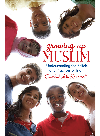
Growing Up Muslim
Understanding the Beliefs and Practices of Islam
فرمت کتاب
ebook
تاریخ انتشار
2012
Lexile Score
1050
Reading Level
6-9
ATOS
8.3
Interest Level
6-12(MG+)
نویسنده
Sumbul Ali-Karamaliشابک
9780375983405
کتاب های مرتبط
- اطلاعات
- نقد و بررسی
- دیدگاه کاربران
نقد و بررسی

nyanchica - The author is Muslim and talks about what it was like to grow up in California being Muslim and how her days and holidays are different from most traditional families and that it wasn't a bad thing to be different. Her favorite holiday is Thanksgiving because she loves pumpkin pie!

July 16, 2012
Ali-Karamali—practicing Muslim, mother, and Islamic law expert—adapts many of the concepts she explained in her well-received The Muslim Next Door: The Qur’an, the Media, and That Veil Thing (2008), for a middle-grade audience. Citing anecdotes from her own childhood, such as when she unknowingly ate pork at school, Ali-Karamali lays out the basics, including fasting during the month of Ramadan; the required five-times-a-day prayer; and some of the intricacies of the Islamic religion. She is equitable in describing varying Muslim interpretations and observance levels (for instance, whether eating marshmallows, which could contain gelatin made from pigs, is haram, or impermissible). Muslim and non-Muslim children alike will enjoy trying out the Ramadan recipes, and adult readers may also benefit from the quick and informative read. Adult Muslim readers may bristle at some conclusions and brief treatment of controversial issues among American Muslims like dating, a practice that has attracted differing interpretations of Islamic views about male-female relations. Other authors have covered the same territory, but this is a helpful, easy-to-read update. Ages 10–up. (Aug.)■

July 15, 2012
Ali-Karamali offers plenty of anecdotes about growing up Muslim in America in a conversational tone that is undermined by poor organization. The work explores a range of questions that non-Muslims might have about followers of Islam. Ranging from a discussion of Muslim holidays or the kinds of clothes worn by Muslims to the development of Islam, the author explains these topics in a friendly, engaging manner. She provides several examples of Muslim practices around the world, going beyond her American experiences to reflect Islam's diversity. Chapters are organized into three fact-filled sections on beliefs and practices, the development of Islam and current Muslim demographics. Unfortunately, beginning with the practical questions about food, fasting and fashion delays important concepts such as how jihad is not equivalent to terrorism and whether Islam mandates women wear face veils (in a word, no). Compounding this basic conceptual flaw, this organizational choice necessitates clunky references to later chapters. Moreover, it is not until Chapter 4 that cited figures or quotes are provided references, an example of sloppy scholarship. Readers will find answers to basic questions about Muslims, yet they might not understand the bigger picture if they don't hang in until the end. (notes, bibliography, index) (Nonfiction. 12-16)
COPYRIGHT(2012) Kirkus Reviews, ALL RIGHTS RESERVED.

September 1, 2012
Gr 6 Up-Ali-Karamali's primer offers an informal, highly personal introduction to Islam. Chronicling her experience growing up Muslim in California, she comfortably discusses major aspects of the faith such as prayer, fasting, and theology as well as food, fashion, and relationships, while connecting these topics to her daily life. The relaxed presentation makes the information more interesting and accessible to readers who would otherwise find it difficult to follow. The writing flows smoothly as if in conversation, making it understandable and appealing. However, the informality does not detract from the accuracy. A few diagrams and a select, scholarly list for further reading are included. This unique introduction is a good choice for dispelling misconceptions and prejudice about this faith, and will appeal to readers of human-interest stories.-Justin Parrott, Columbus Metropolitan Library, OH
Copyright 2012 School Library Journal, LLC Used with permission.

November 15, 2012
Grades 5-8 The American author, born to parents who had emmigrated from India, discusses in broad outline some facts and facets of Islam and looks at Muslim identity in contemporary Western society. Ali-Karamali's conversational writing style relies heavily on her own experiences and interests; for instance, food is a repeated motif here, even beyond the first chapter, which is about Muslim eating rules. The book supplies historic context for some Islamic prohibitions, differentiates between religious context and other cultural influences, and keeps the narrative moving quickly. For kids without much knowledge of Islam, this short book can be a starting point, perhaps of most value to students who lack any direct knowledge of Muslim peers and/or have research needs to satisfy. It also will bring up more focused questions that readers can explore elsewhere.(Reprinted with permission of Booklist, copyright 2012, American Library Association.)

























دیدگاه کاربران